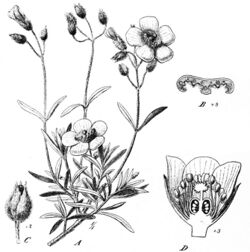Biology:Cistus munbyi
| Cistus munbyi | |
|---|---|

| |
| Scientific classification | |
| Kingdom: | Plantae |
| Clade: | Tracheophytes |
| Clade: | Angiosperms |
| Clade: | Eudicots |
| Clade: | Rosids |
| Order: | Malvales |
| Family: | Cistaceae |
| Genus: | Cistus |
| Species: | C. munbyi
|
| Binomial name | |
| Cistus munbyi Pomel[1]
| |
| Synonyms[1] | |
| |
Cistus munbyi is a shrubby species of flowering plant in the family Cistaceae, with white flowers. Related to and resembling Cistus clusii, it is native to Morocco and Algeria in western north Africa.
Description
Cistus munbyi has narrow linear leaves with a single prominent vein, generally 6–30 mm (0.2–1.2 in) long by 1–4 mm (0.0–0.2 in) wide, with edges that are turned down (revolute). The upper surfaces of the leaves are smooth, the lower surfaces have a dense covering of short stellate hairs. It has white flowers.[2] C. munbyi resembles C. clusii, but the flower-bearing branches are longer and the flower stalks (peduncles) and sepals are covered with white hairs, making them appear silky ("sericeus").[3]
Taxonomy
Giles Munby gave a description of this species under the name Cistus sericeus in 1847.[3][4] The name had already been published by Martin Vahl in 1790, so that Munby's name is illegitimate.[5] Auguste Nicolas Pomel published the currently used name in 1874,[1] the specific epithet munbyi honouring Munbyi.
Phylogeny
Molecular phylogenetic studies place C. munbyi in a clade with Cistus clusii within the larger white and whitish pink clade of Cistus species, sister to all the remaining white and whitish pink flowered species.[6][7]
| Species-level cladogram of Cistus species. |
| Species-level cladogram of Cistus species, based on plastid and nuclear DNA sequences.[6][8][2][7] |
Distribution and habitat
Cistus munbyi is native to western north Africa, occurring at elevations of up to 100 metres (330 ft) along the Mediterranean coasts of Morocco and Algeria. It occurs in dry, sunny locations, generally in alkaline soils among bushy vegetation.[2] Munby's description was based on a specimen from the cliffs east of Oran.[3]
References
- ↑ 1.0 1.1 1.2 "Cistus munbyi", The Plant List, http://www.theplantlist.org/tpl1.1/record/kew-2723526, retrieved 2015-03-02
- ↑ 2.0 2.1 2.2 Guzman, B.; Lledo, M.D.; Vargas, P. (2009). "Adaptive Radiation in Mediterranean Cistus (Cistaceae)". PLOS ONE 4 (7): e6362. doi:10.1371/journal.pone.0006362. PMID 19668338. Bibcode: 2009PLoSO...4.6362G.
- ↑ 3.0 3.1 3.2 Munby, G. (1847), "C. sericeus" (in French, Latin), Flore de l'Algérie ou catalogue des plantes indigènes, Alger & Montpellier: J.B. Baillière, http://bibdigital.rjb.csic.es/ing/Libro.php?Libro=4261&Pagina=69, retrieved 2015-03-21
- ↑ "Cistus sericeus Munby", The Plant List, http://www.theplantlist.org/tpl1.1/record/kew-2723652, retrieved 2015-03-20
- ↑ "IPNI Plant Name Details for Cistus sericeus Munby", The International Plant Names Index, http://www.ipni.org/ipni/idPlantNameSearch.do?id=168487-1, retrieved 2015-03-21
- ↑ 6.0 6.1 Guzmán, B.; Vargas, P. (2005), "Systematics, character evolution, and biogeography of Cistus L. (Cistaceae) based on ITS, trnL-trnF, and matK sequences", Molecular Phylogenetics and Evolution 37 (3): 644–660, doi:10.1016/j.ympev.2005.04.026, PMID 16055353, p. 646
- ↑ 7.0 7.1 Civeyrel, Laure; Leclercq, Julie; Demoly, Jean-Pierre; Agnan, Yannick; Quèbre, Nicolas; Pélissier, Céline; Otto, Thierry (2011), "Molecular systematics, character evolution, and pollen morphology of Cistus and Halimium (Cistaceae)", Plant Systematics and Evolution 295 (1–4): 23–54, doi:10.1007/s00606-011-0458-7
- ↑ Guzmán, B.; Vargas, P. (2009). "Historical biogeography and character evolution of Cistaceae (Malvales) based on analysis of plastid rbcL and trnL-trnF sequences". Organisms Diversity & Evolution 9 (2): 83–99. doi:10.1016/j.ode.2009.01.001.
Wikidata ☰ Q15331572 entry
 |

